On 02 March 1962, General Ne Win overthrew the government, suspended the constitution, installed himself as chief of state, and pursued a socialistic program with nationalization of nearly all industries and trade. On 04 January 1974, a new constitution adopted by referendum established Burma as a "socialistic republic" under one-party rule, and the country name was officially changed to the Union of Myanmar.
Japanese Occupation of Burma in World War II |
Japanese Government |
1942-1944 Issue |
| The Japanese invaded Burma in January 1942. They conquered Mandalay on 21 May, 1942 forcing the British to retreat into India. The Japanese held Burma until the second Allied campaign of 1944; although an official surrender did not take place until August 1945 In 1942 the Japanese issued paper script currency of 1, 5 and 10 cents and &freac14, ½, 1, 5, 10 and 100 Rupees. |
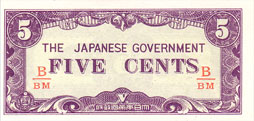 | P10 - 5 Cents
Size: 99 x 48 mm |
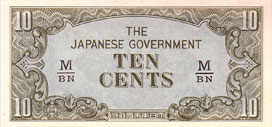 | P11a - 10 Cents
Size: 106 x 51 mm |
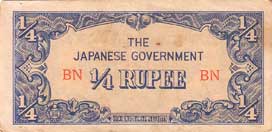 | P12 - ¼ Rupee
Size: 106 x 51 mm |
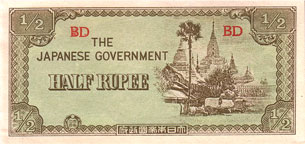 | P13b - ½ Rupee
Front: Ananda Temple in Pagan at right
Size: 119 x 57 mm |
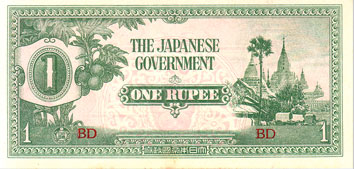 | P14 - 1 Rupee
Front: Ananda Temple in Pagan at right
Size: 138 x 66 mm |
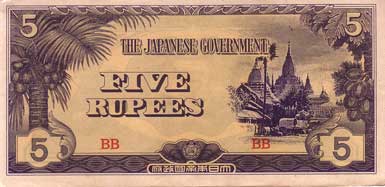 | P15 - 5 Rupees
Front: Ananda Temple in Pagan at right
Size: 150 x 72 mm |
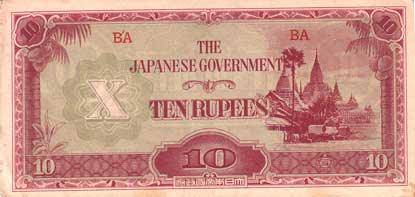 | P16 - 10 Rupees
Front: Ananda Temple in Pagan at right
Size: 162 x 77 mm |
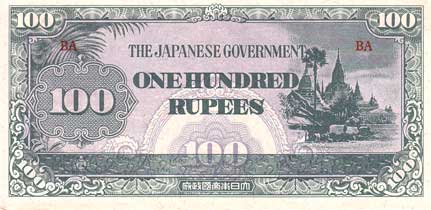 | P17 - 100 Rupees
Front: Ananda Temple in Pagan at right
Size: 169 x 82 mm |
Military |
Military Administration of Burma |
1945 ND Issue |
| "MILITARY ADMINISTRATION OF BURMA. LEGAL TENDER IN BURMA ONLY" overprint on India notes. During World War II, Burma became a major front-line in the Southeast Asian Theatre. Initially the Japanese-led Burma Campaign succeeded and the British were expelled from most of Burma, but the British counter-attacked using primarily troops of the British Indian Army. By July 1945, the British had retaken the country. |
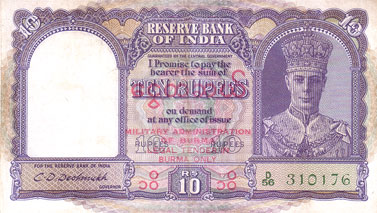 | P28 - 10 Rupees
Serial Number: D/56 310176
Front: Portrait of King George IV at right, red overprint on India P24 "MILITARY ADMINISTRATION OF BURMA, LEGAL TENDER IN BURMA ONLY" at center, spindle hole at center right
Back: Dhow at center , denomination in 7 Indian languages at right
Watermark: Portrait of King George IV
Size: 147 x 82 mm |
State of Burma - Post World War II |
Burma Currency Board |
1947 ND Provisional Issue |
| In 1947, Aung San became Deputy Chairman of the Executive Council of Burma, a transitional government. But in July 1947, political rivals assassinated Aung San and several cabinet members. |
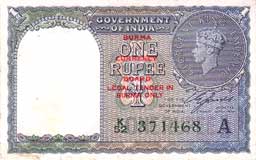 | P30 - 1 Rupee
Serial Number: K/52 3711468
Front: Coin with King George IV at upper right (perfectly aligned with reverse of coin on the back), red overprint "BURMA CURRENCY BOARD, LEGAL TENDER IN BURMA ONLY" at center, "A" inset at lower right
Back Reverse of coin at upper left, denomination in 7 Indian languages at center
Size: 100 x 63 mm |
|
Union Bank of Burma |
1953 ND Rupee Issue |
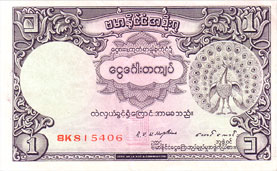 | P38 - 1 Rupee
Serial Number: 8K 815406
Front: Peacock at right
Back: Sailing dhows at center, "ONE RUPEE" in circle at left
Watermark: Peacock
Size: 108 x 67 mm |
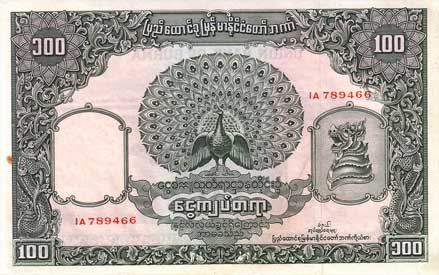 | P41 - 100 Rupees
Serial Number: IA 789466
Front: Peacock at center, Chinthe head at right
Back: Farmer plowing rice field with buffalo, "ONE HUNDRED RUPEES" at lower right
Watermark: Peacock
Size: 171 x 107 mm |
|
1953 ND Issue |
| In 1953, the Union Bank of Burma introduced the first kyat notes, in denominations of 1, 5, 10 and 100 kyats. These were very similar in design to the last series of rupee notes, issued earlier the same year. |
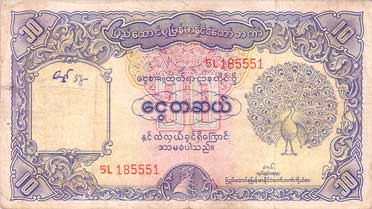 | P44 - 10 Kyats
Serial Number: 5L 185551
Front: Peacock at right, Chinthe head at bottom center
Back: Elephant with mahout lifting a log at center, staple holes at right, "TEN KYATS" at lower right
Watermark: Peacock
Size: 145 x 81 mm |
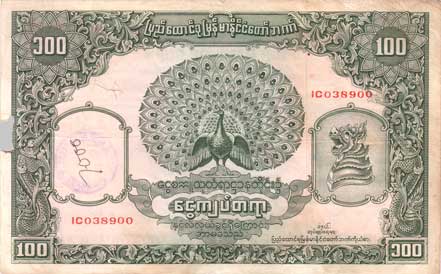 | P45 - 100 Kyats
Serial Number: IC038900
Front: Peacock at center, Chinthe head at right, tear from staple holes at left
Back: Farmer plowing rice field with buffalo, "ONE HUNDRED KYATS" at lower right
Watermark: Peacock
Size: 172 x 107 mm |
|
1958 ND Issue |
| In 1958, 20 and 50 kyats notes were introduced. The 50 and 100 kyat notes were demonetized on May 15, 1964. This was the first of several demonetizations, ostensibly carried out with the aim of fighting black marketeering. |
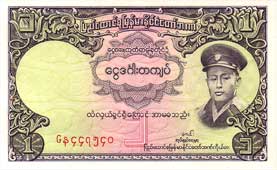 | P46 - 1 Kyats
Front: Portrait of General Aung San with cap at right
Back: Dhows sailing at center
Watermark: General Aung San with cap
Size: 108 x 66 mm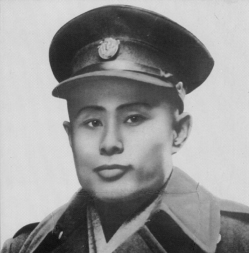 Bogyoke (General) Aung San (13 February 1915-19 July 1947) was a Burmese revolutionary, nationalist, and founder of the modern Burmese army, the Tatmadaw. He was instrumental in bringing about Burma's independence from British colonial rule, but was assassinated six months before its final achievement. He is recognized as the leading architect of independence, and the founder of the Union of Burma. Affectionately known as "Bogyoke" (General), Aung San is still widely admired by the Burmese people, and his name is still invoked in Burmese politics to this day. Aung San was the father of Nobel Peace laureate and opposition leader Aung San Suu Kyi, who has been under house arrest for almost two decades. Bogyoke (General) Aung San (13 February 1915-19 July 1947) was a Burmese revolutionary, nationalist, and founder of the modern Burmese army, the Tatmadaw. He was instrumental in bringing about Burma's independence from British colonial rule, but was assassinated six months before its final achievement. He is recognized as the leading architect of independence, and the founder of the Union of Burma. Affectionately known as "Bogyoke" (General), Aung San is still widely admired by the Burmese people, and his name is still invoked in Burmese politics to this day. Aung San was the father of Nobel Peace laureate and opposition leader Aung San Suu Kyi, who has been under house arrest for almost two decades.
|
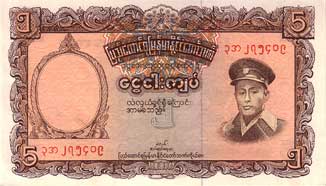 | P47 - 5 Kyats
Front: Portrait of General Aung San with cap at right
Back: Woman and spinning wheel at right, arms at upper left
Watermark: General Aung San with cap
Size: 127 x 73 mm
|
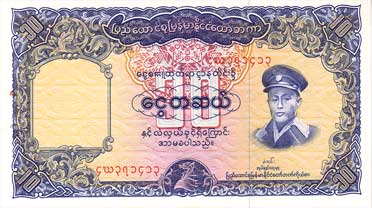 | P48 - 10 Kyats
Front: Portrait of General Aung San with cap at right
Back: Elephant lifting log at center
Watermark: General Aung San with cap
Size: 145 x 82 mm |
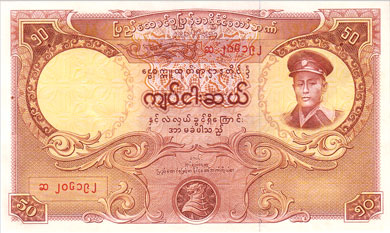 | P50 - 50 Kyats
Front: Portrait of General Aung San with cap at right
Back: Mandalay Temple at center, staple holes at right
Watermark: General Aung San with cap
Size: 152 x 91 mm |
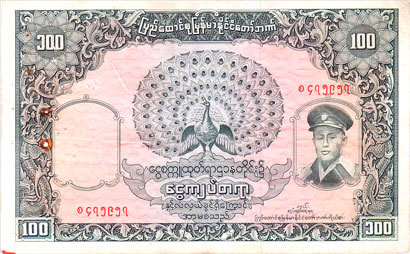 | P51 - 100 Kyats
Front: Portrait of General Aung San with cap at right, peacock at center
Back: Farmer plowing with two water buffalo at center, staple holes at right
Watermark: General Aung San with cap
Size: 160 x 99 mm |
|
Peoples Bank of Burma |
1965 ND Issue |
| The Peoples Bank of Burma took over note production in 1965 with an issue of 1, 5, 10 and 20 kyat notes. |
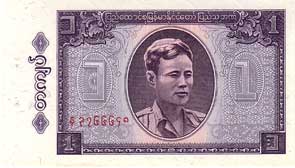 | P52 - 1 Kyats
Front: Portrait of General Aung San at center, two staple hole punchs at left center
Back: Fisherman at center, arms at upper left
Watermark: Pattern throughtout paper
Size: 115 x 65 mm |
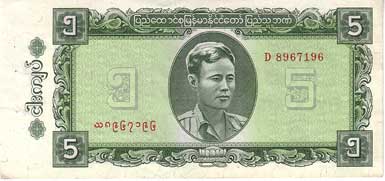 | P53 - 5 Kyats
Front: Portrait of General Aung San at center, two staple hole punchs at left center
Back: Man with ox at center, arms at upper left
Watermark: Pattern throughtout paper
Size: 150 x 70 mm |
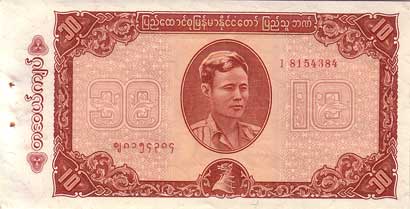 | P54 - 10 Kyats, 1965
Front: Portrait of General Aung San at center, two staple hole punchs at left center
Back: Woman picking cotton at right, arms at upper left
Watermark: Pattern throughtout paper
Size: 160 x 81 mm |
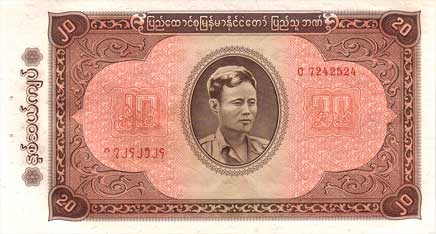 | P55 - 20 Kyats, 1965
Front: Portrait of General Aung San at center, two staple hole punchs at left center
Back: Farmer on tractor tilling a field at right, arms at upper left
Watermark: Pattern throughtout paper
Size: 170 x 91 mm |
|
Union of Burma Bank |
1972-1979 ND Issue |
| In 1972, the Union of Burma Bank took over note issuance, with notes introduced between 1972 and 1979 for 1, 5, 10, 25, 50 and 100 kyats. The notes were printed by the Security Printing Works in Wazi, Upper Burma (established circa 1972) under the technical direction of the German firm Giesecke & Devrient. |
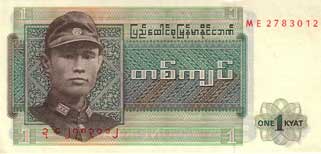 | P56 - 1 Kyat, 1972
Front: Military portrait of General Aung San at left
Back: Ornate native wheel assembly at right
Watermark: General Aung San
Size: 125 x 60 mm |
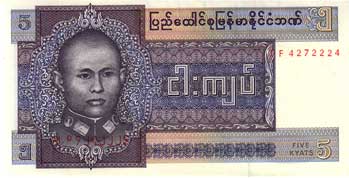 | P57 - 5 Kyat, 1973
Front: Military portrait of General Aung San at left
Back: Palm tree at left center
Watermark: General Aung San
Size: 136 x 70 mm |
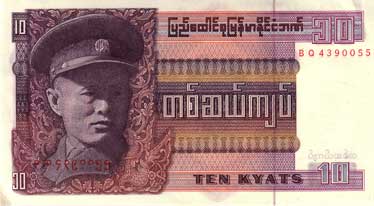 | P58 - 10 Kyats, 1973
Front: Military portrait of General Aung San at left
Back: Native ornaments at left center
Watermark: General Aung San
Size: 146 x 80 mm |
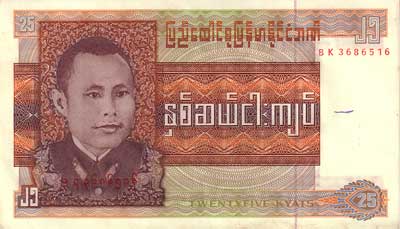 | P59 - 25 Kyats, 1972
Front: Military portrait of General Aung San at left
Back: Mythical winged creature
Watermark: General Aung San
Size: 156 x 90 mm |
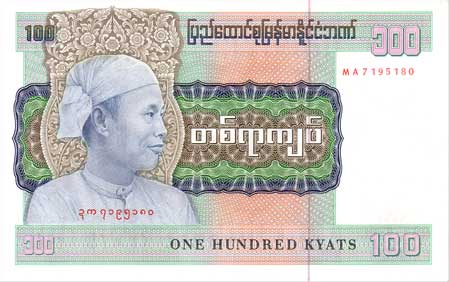 | P61 - 100 Kyats, 1976
Front: Portrait of General Aung San at left
Back: Wheel and musical string instrument at center left
Watermark: General Aung San
Size: 175 x 110 mm |
|
1985-1987 Issue |
On 03 November 1985, the 25, 50, and 100 Kyat notes were demonetized without warning, though the public was allowed to exchange limited amounts of the old notes for new ones. All other denominations then in circulation remained legal tender.
On 10 November 1985, 75 Kyat notes were introduced, the odd denomination possibly chosen because of dictator Ne Win's predilection for numerology; the 75 Kyat note was supposedly introduced to commemorate his 75th birthday. It was followed by the introduction of 15 and 35 Kyat notes on August 1, 1986. |
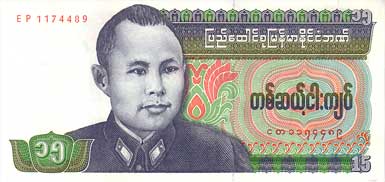 | P62 - 15 Kyats, 1986
Front: General Aung San at left center
Back: Dancer at left
UV: Blue and green fluorescent fibers
Watermark: General Aung San
Size: 150 x 71 mm |
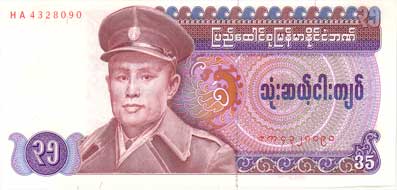 | P63 - 35 Kyats, 1986
Front: General Aung San wearing military cap at left center
Back: Dancer at left
UV: Blue and green fluorescent fibers
Watermark: General Aung San
Size: 155 x 74 mm |
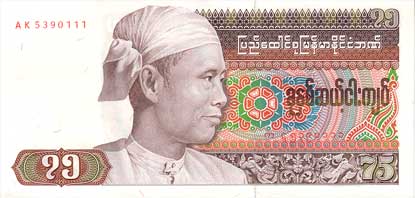 | P65 - 75 Kyats, 1985
Front: General Aung San at left center
Back: Dancer at left
UV: Blue and green fluorescent fibers
Watermark: General Aung San
Size: 162 x 78 mm |
|
On September 5, 1987, under the regime of General Ne Win, Sein Lwin, The Secretary of Union Council signed an order that dissolved the 25 Kyats, 35 Kyats, and 75 Kyats notes issued by The Bank of the Union of Burma.
| "That September 5th was a Saturday. The time when Myanma Radio announced the withdrawal of the bills was at 11am. Since it was a Saturday, the people were out on the streets to visit places, friends or to go shopping and the people who had been preparing hastily to go out all froze in place when the news was announced on the radio. Within a couple of hours, everyone just stopped. The streets became empty, and it was as if some terrible fate had fallen." - The blogger Niknayman |
After the withdrawl of those currency bills, the new currency bills of 45 Kyats and 90 Kyats were released. However, the government made no motion of exchanging the bills that had been abolished.
The new currency bills (45 Kyats and 90 Kyats) were divisible by 9, and that no. 9 is considered lucky for General Ne Win. Also, the pictures of Sayar San and Thakhin Phoe Hla Gyi (two Burmese revolutionists during the colonial era) had been placed on the bills, instead of pictures of General Aung San (whose pictures had been on all 3 abolished bills). |
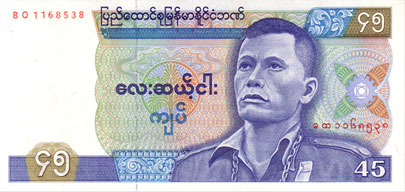 | P64 - 45 Kyats, 1987
Front: Po Hla Gyi at right
Back: Two workers at center left, oil field at center
UV: Yellow and green fluorescent fibers
Watermark: Po Hla Gyi
Size: 158 x 75 mm |
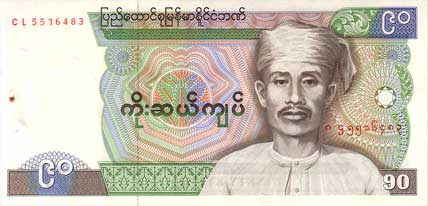 | P66 - 90 Kyats, 1987
Front: Seya San at right center
Back: Farmer plowing with oxes at center left, planting rice at upper right
UV: Blue and green fluorescent fibers
Watermark: General Aung San
Size: 167 x 80 mmSeya San, Saya San or Galon Saya San (born 24 October 1876, executed 16 November 1931) was a noted monk, a Burmese medicine man or shaman and the leader of the Burmese peasant revolt of 1930-1931 and pretender to the Burmese throne. He led the first concerted effort to forcefully resist British domination. As a result, the British executed him by hanging. Saya San is remembered as a nationalist hero who led the masses against the colonial state. |
 The Socialist Republic of the Union of Burma Paper Money Collection
The Socialist Republic of the Union of Burma Paper Money Collection The Socialist Republic of the Union of Burma Paper Money Collection
The Socialist Republic of the Union of Burma Paper Money Collection